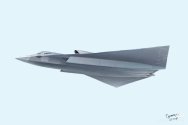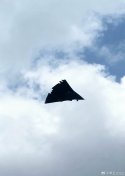You are using an out of date browser. It may not display this or other websites correctly.
You should upgrade or use an alternative browser.
You should upgrade or use an alternative browser.
Chengdu next gen combat aircraft (?J-36)
- Thread starter Blitzo
- Start date
Last edited:
Come on ...
Engineer
Major
DSI is very dependent on the upstream flow condition. A change to the nose of the aircraft could mean a redesign of the DSI. There might simply be no point of using a DSI for an early prototype.In this stream, Yankee was imply that 36011's caret intake was done for two reasons:
1. CAC has always wanted to give caret intake a try, if nothing else to get a hands on feel for aerodynamic and RCS characteristics of these intakes. Though unless caret intake turns out to be much better than CAC's estimation they've always perferred DSI.
2. They were judging that NGAD/F-47 prototype would fly sometime towards the middle of this year. Since caret intake was a much simpler arrangement than DSI 36011 could be ready for maiden flight much earlier than 36022, thus beating the Americans to the line.
Point 2 turned out to be too optimistic in terms of US 6th gen development, but their own estimation on when the two prototypes were correct. If indeed they only went for 36022 and the Americans worked as fast as their estimation then F-47 would have beaten J-36 for maiden flight.
Yankee said DSI is much more complicated than people realize and even for CAC, designing a completely new one for a new plane takes time. J-20's DSI is not just a fixed piece but actually has an adjustable component to it. However he has yet to observe anyone outside of China coming close to correctly guessing now the adjustability is done.
There’s really only two feasible theories that I can think of. One is the hexagonal side vents are actually additional intake and bleed systems to deal with choked flow conditions and also spillage drag. The other is that the throat area itself is adjustable past the bump. Both kinds of solutions could probably also be employed together if they really need to have greater control authority over the flow conditions going into the inlet.
Not too surprising that they need to make it adjustable given that J-20 is optimized for high speed and needs good pressure recovery over a range of different flight regimes.
They also said a lot about the new semi-stealth trainer, saying that it has good supersonic combat capabilities and enables full BVR tactics in training and also will be used as export. Currently BVR training is mostly done on J10S and J11B since old trainers doesn't fly fast enough to enable many tactics.Perhaps veering a bit too much off-topic, but did the podcast said anything about other programs such as H-20, 004 CVN etc (that can be added in the relevant topics) or was it mostly focused on J-36?
It is interesting to note that this implies that they are indeed paying a lot of attention to and attempting beat the timelines of the American project, contrary to some posters on this forum who claim otherwise (that they are proceeding "purely" on their own pace without regard for the progress on F-47).In this stream, Yankee was imply that 36011's caret intake was done for two reasons:
1. CAC has always wanted to give caret intake a try, if nothing else to get a hands on feel for aerodynamic and RCS characteristics of these intakes. Though unless caret intake turns out to be much better than CAC's estimation they've always perferred DSI.
2. They were judging that NGAD/F-47 prototype would fly sometime towards the middle of this year. Since caret intake was a much simpler arrangement than DSI 36011 could be ready for maiden flight much earlier than 36022, thus beating the Americans to the line.
Point 2 turned out to be too optimistic in terms of US 6th gen development, but their own estimation on when the two prototypes were correct. If indeed they only went for 36022 and the Americans worked as fast as their estimation then F-47 would have beaten J-36 for maiden flight.
Yankee said DSI is much more complicated than people realize and even for CAC, designing a completely new one for a new plane takes time. J-20's DSI is not just a fixed piece but actually has an adjustable component to it. However he has yet to observe anyone outside of China coming close to correctly guessing now the adjustability is done.


